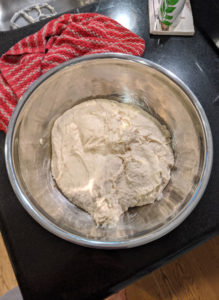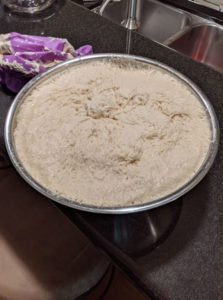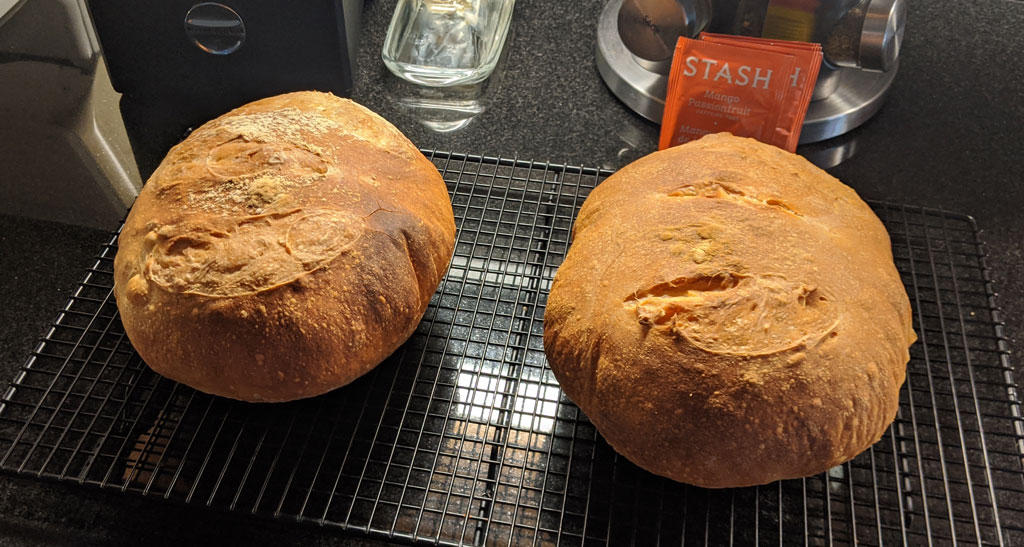
For the last three years, I’ve significantly reduced my carbohydrate intake. More specifically, I’ve eaten a lot less wheat-based carbohydrates, which significantly reduced my bread consumption. My diet changed from eating 3-4 servings of bread per day to 3-4 servings every month or so. So instead of eating carbohydrates, I’ve consumed a lot more protein and natural fats such as nuts.
My motivation came from what I read in Wheat Belly, Grain Brain, Primal Body – Primal Mind, and It Starts with Food. My desire to get my weight below 160 pounds was also a significant factor. While I’ve adjusted to the diet and don’t necessarily miss bread, I decided it was time for a change. Variety is the spice of life, right?
I decided to take the bold move of adding bread back into my diet, but under one condition. It couldn’t be any bread. I wanted to bake it on my own so I could control the ingredients being used. I didn’t want to pollute my body with all the ingredients found in a store-bought loaf of bread that I either don’t know or can’t pronounce.
The Research Process

Now that I had my goal, the question became where to start? I had some experience baking cookies and pies, but I had never attempted a loaf of bread. I had heard stories of people struggling with bread machines, baby-sitting sourdough starters, and wrestling to control the behavior of yeast. None of this sounded like fun.
I set myself a goal of keeping the process simple. It meant using what we had in our kitchen. I didn’t want to buy a bread machine or any other specialized equipment. I also wanted to stick to basic ingredients that we’re readily available in our pantry. Finally, I didn’t want to mess with managing a sourdough starter. I wanted a process that was controllable and would yield more predictable results.

As with most projects I take on these days, Google came to the rescue. After trying a few different searches, I stumbled upon a recipe for “No-Kead Crusty White Bread” on the King Arthur Baking Company website. It was exactly what I was looking for. It required no specialized equipment and required only four ingredients – flour, water, salt, and yeast. The only thing I was missing was the yeast, which was available for order on the King Arthur baking site.
Making the Bread
Ingredients in hand, I set out to make my first loaf of bread. As with anything you do the first time, you learn a lot. Here a few of the lessons I learned:
- Weighing the ingredients is not just important, it’s critical. Baking is way different than cooking. Slight variations in the ratios of ingredients can have a dramatic impact on the results, which I learned first hand. If you don’t already own a kitchen scale, I would highly recommend investing in one.
- The SAF Red Instant Yeast on the King Arthur website works great. I don’t know if it’s the best yeast, but it is very easy to work with and produces consistent results. It’s also affordable and yields quite a few loafs of bread.
- Bread dough is sticky, and messy. One piece of equipment I wish I had when I first started baking was a bench scraper, which I’ve since bought. It’s not expensive, makes life a lot easier, and has lots of other uses around the kitchen besides baking bread.
- Patience pays off. The longer you can let the dough set in the fridge, the more flavor it develops. According to the King Arthur website, you can chill it for up to 7 days.
- Forming and slashing a bread loaf are two skills I need a lot of work on. I’ve watch a lot of videos on the process, my favorite being the one from the folks at Proof Bakery in Arizona. As he says, unless you work at bakery, you need to bake a lot of loaves to master the technique (skip to around minute 38 in the video below to see the master in action).
Results
Bear in mind that it’s been over three years since I’ve eaten bread regularly, so eating any type of bread is a treat. But I’d have to say that bread made from scratch is good, really good. I don’t know if it’s psychological because I know the effort that went into making it, or if it has to do with the freshness. Regardless of why, the finished product is good. It’s great lightly buttered, but it’s even better when toasted. Best of all, I love the simplicity. No chemicals, no preservatives, no additives. It’s just flour, water, salt and yeast.

Improvements
Now that I’m hooked on baking my own bread, there are a couple of improvements I want to make. First off, I want to invest in a double dutch oven. When baking bread, keeping the air humid increases the crunch of the crust. I try to keep the oven environment humid with a pan of water, but I don’t think it’s enough. Everything I’ve researched says modern kitchen ovens are designed to vent humidity. A double dutch oven locks in the moisture that bakes out of the bread which, supposedly, gives it that extra crunch.
Second, I want to start using a brotform or banneton to proof my bread. Either of these helps the bread develop and hold its shape during baking so the bread has a consistent look to it. I’ve gotten a little better at shaping my loaves, but they still tend to come out all over the place.
There’s one other thing that I’d like to try. Even though it will add some time and stress to the process, I want to attempt to grow and maintain a sourdough starter. I’m curious about the process, the chemistry, and the difference in taste. I’ll do my best to document the process and my results in a future post.
What I’ve learned
So what have I learned from my bread baking experience? You don’t need a lot of tools, special equipment, or time to bake bread. It just takes patience and practice. Given how easy it is to make, it’s worth the investment because the end product is good. It’s way better than what you get in the store. While I’m not certain it’s any better for you, I know it can’t be any worse. At least I know what’s in it, and all the ingredients have less than two syllables. So for now, my new diet experiment involves a little bread, with the caveat that it has to be of the home made variety.

Pingback: Sourdough Lessons - Gregg Borodaty